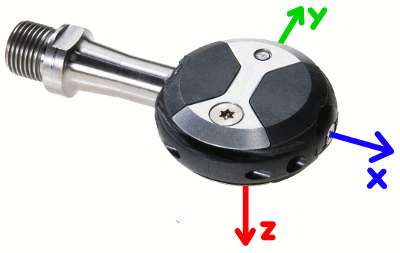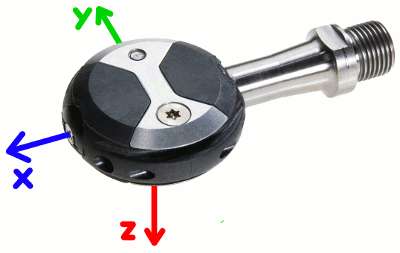Metrigear Vector Pt 4: Interpretation of Forces
Okay, so back to the Metrigear Vector for a bit.
What I discussed before was how the MetriGear Vector is trying to move the emphasis from power to force. Get force right, get velocity right, and power is automatically right.
I mentioned how one can derive twelve components of force. One of these components, Frz-Flz, drives the chain, and therefore provides propulsive force. It is assumed none of the other force components are propulsive.
I need to make a disclaimer here: I don't work for Metrigear, so can't be sure they make the same assumptions I do. I'm just running with the idea and saying what assumptions I might make.


Axes for pedals at 3 and 9'oclock
So, other than the propulsive mode, I think the next most interesting mode is Frz+Flz. This describes right-left imbalance. Obviously at any point in the pedal stroke, the right will be applying more or less torque to the crank than the left. But averaged over the pedal stroke, the difference should, if the pedal stroke is perfectly balanced, average to zero. If this value is positive, then the right foot is doing more work than the left. If negative, the left is working more. Obviously it will never average to exactly zero. What it it's not zero? That's a good question. But I can easily imagine a rider might want to focus on engaging the less active side more.
Here I'm discussing force on the pedal. But what drives the chain is torque on the crank. The relationship between the two, for the moments consisting of Frz and Flz, is a factor equal to the crank length. Now, Metrigear says the Vector needs to be updated with the present crank length. This is interesting, but basically it uses crank length to convert force into torque. Torque becomes power by multiplying by angular velocity, which is equivalent (for pedals moving in a circle) to cadence.
There's other forces, however, which could be measured by Vector. For example, Fx (on each pedal) is a force applied along the spindle direction. This is equivalent to pushing out with a show (for a positive value) or pushing inward with a shoe (for a negative value). This may be very useful. For example, when cornering, it's conventional practice to push down with the outside foot, using that pressure to help control the bike. There will then be a component of Fx to the outward pedal.
However, for straight-line pedaling, simple-minded thinking suggests Fxl and Fxr should be small. If there were a generally positive value of Fxl and Fxr, that might suggest the cleats were mounted too far out, it seems. Or a negative value might imply the cleats were mounted too far in. In each case the foot might be struggling to find a more comfortable lateral position. Improper cleat placement can lead to torquing the knee, which leads to knee pain. I think one of the reasons some riders claim Speedplays lead to knee pain is that Speedplays have no lateral float (only rotational float) and thus proper setting of lateral cleat position is critical. Not everyone is going to get it right. An alternative to moving the cleat is to move the pedal. For example, spacers may be used at the crankset, or a crankset of a different "Q-factor" could be used, or Speedplay sells spindles in different lengths. I'm not sure you'd be happy about swapping spindles if you'd just dropped the better part of $1k on Metrigear Vector spindles in the wrong length, though.
Then there's Fy. I've already discussed Fyl + Fyr, pushing forward on the pedals. Fyl ‒ Fyr would be a measure of pushing forward with one pedal and backward with the other. I'm not sure how to interpret these forces. Some would say any force not involved with direct propulsion should be minimized. But I don't believe there's any evidence to support this simplistic view. So it will be interesting to see how numbers like these get used.
One more comment: I'm being sloppy with coordinates, since I'm assuming pedals in the 3 o'clock and 9 o'clock position. But pedals move in circles in the frame of the bike. In this frame, the x-direction as I define it stays x. I'll assume the z-direction always points in the direction of propulsive force. Then the y-direction, if it is to remain orthogonal to x and z, will not always point forward. In my discussion of the forward force, then, a measure of the force pointing forward would need to be a linear combination of the x and y forces, with coefficients determined by a sine and cosine of the crank orientation in the frame of the bicycle (although in the frame of the spindle, forward is always the same direction) The actual Fy values may be less meaninful than parameters like these derived in part from Fy.
Next time: the torques.
What I discussed before was how the MetriGear Vector is trying to move the emphasis from power to force. Get force right, get velocity right, and power is automatically right.
I mentioned how one can derive twelve components of force. One of these components, Frz-Flz, drives the chain, and therefore provides propulsive force. It is assumed none of the other force components are propulsive.
I need to make a disclaimer here: I don't work for Metrigear, so can't be sure they make the same assumptions I do. I'm just running with the idea and saying what assumptions I might make.


Axes for pedals at 3 and 9'oclock
So, other than the propulsive mode, I think the next most interesting mode is Frz+Flz. This describes right-left imbalance. Obviously at any point in the pedal stroke, the right will be applying more or less torque to the crank than the left. But averaged over the pedal stroke, the difference should, if the pedal stroke is perfectly balanced, average to zero. If this value is positive, then the right foot is doing more work than the left. If negative, the left is working more. Obviously it will never average to exactly zero. What it it's not zero? That's a good question. But I can easily imagine a rider might want to focus on engaging the less active side more.
Here I'm discussing force on the pedal. But what drives the chain is torque on the crank. The relationship between the two, for the moments consisting of Frz and Flz, is a factor equal to the crank length. Now, Metrigear says the Vector needs to be updated with the present crank length. This is interesting, but basically it uses crank length to convert force into torque. Torque becomes power by multiplying by angular velocity, which is equivalent (for pedals moving in a circle) to cadence.
There's other forces, however, which could be measured by Vector. For example, Fx (on each pedal) is a force applied along the spindle direction. This is equivalent to pushing out with a show (for a positive value) or pushing inward with a shoe (for a negative value). This may be very useful. For example, when cornering, it's conventional practice to push down with the outside foot, using that pressure to help control the bike. There will then be a component of Fx to the outward pedal.
However, for straight-line pedaling, simple-minded thinking suggests Fxl and Fxr should be small. If there were a generally positive value of Fxl and Fxr, that might suggest the cleats were mounted too far out, it seems. Or a negative value might imply the cleats were mounted too far in. In each case the foot might be struggling to find a more comfortable lateral position. Improper cleat placement can lead to torquing the knee, which leads to knee pain. I think one of the reasons some riders claim Speedplays lead to knee pain is that Speedplays have no lateral float (only rotational float) and thus proper setting of lateral cleat position is critical. Not everyone is going to get it right. An alternative to moving the cleat is to move the pedal. For example, spacers may be used at the crankset, or a crankset of a different "Q-factor" could be used, or Speedplay sells spindles in different lengths. I'm not sure you'd be happy about swapping spindles if you'd just dropped the better part of $1k on Metrigear Vector spindles in the wrong length, though.
Then there's Fy. I've already discussed Fyl + Fyr, pushing forward on the pedals. Fyl ‒ Fyr would be a measure of pushing forward with one pedal and backward with the other. I'm not sure how to interpret these forces. Some would say any force not involved with direct propulsion should be minimized. But I don't believe there's any evidence to support this simplistic view. So it will be interesting to see how numbers like these get used.
One more comment: I'm being sloppy with coordinates, since I'm assuming pedals in the 3 o'clock and 9 o'clock position. But pedals move in circles in the frame of the bike. In this frame, the x-direction as I define it stays x. I'll assume the z-direction always points in the direction of propulsive force. Then the y-direction, if it is to remain orthogonal to x and z, will not always point forward. In my discussion of the forward force, then, a measure of the force pointing forward would need to be a linear combination of the x and y forces, with coefficients determined by a sine and cosine of the crank orientation in the frame of the bicycle (although in the frame of the spindle, forward is always the same direction) The actual Fy values may be less meaninful than parameters like these derived in part from Fy.
Next time: the torques.

Comments
There is only one problem that I see with what you are discussing... and that is I doubt that the sensor (although I do not know the model brand or number) would be able to measure in both x&y as well as z.
g
At the heart of Vector is a custom-designed system with over 60 piezoresistive strain gauges, accelerometers, and temperature sensors
With 6 accelerometers per side, one temperature sensor per side, that leaves at least 31 - 7 = 24 strain gauges per side. That certainly seems like it would be enough to measure 6 bending moments per side.
24 would four strain gauges per degree of freedom per side. Six acclerometers would allow for the measurement of acceleration and change in the rate of rotation about each of 3 principal axes per side. And of course you need only one temperature sensor.
Part of the issue is that it's one thing to talk about a system where sensors are perfectly aligned with axes of interest. But the orientation of the pedal spindle is unpredictable, and the electronics may not be perfectly aligned within the hole. So no doubt there is some redundancy in the system to improve sensitivity given an uncertain orientation. That's encouraging.
Leaving that aside. It would be interesting to speculate how to measure the pedal velocity. Is an accelerometer necessary, or can the velocity be calculated from relative changes in forces measured by the sensors? Could a simple sensor to measure angle of sensor do the trick ?
Interesting ....